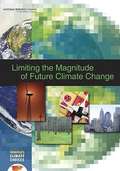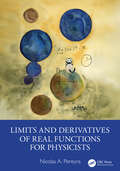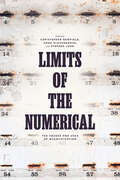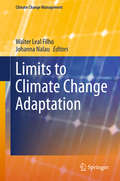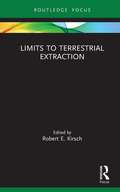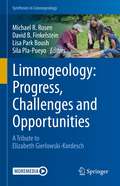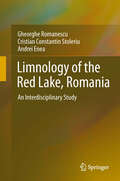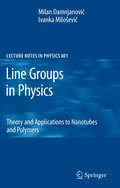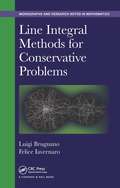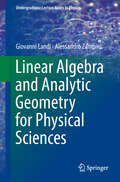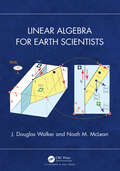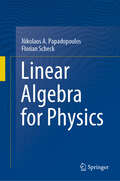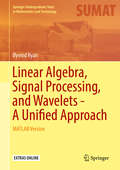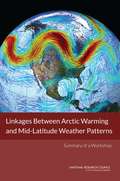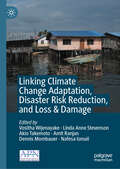- Table View
- List View
Limiting Global Warming to Well Below 2 °C: Energy System Modelling and Policy Development (Lecture Notes In Energy #64)
by George Giannakidis Maryse Labriet Kenneth Karlsson B. Ó GallachóirThis book presents the energy system roadmaps necessary to limit global temperature increase to below 2°C, in order to avoid the catastrophic impacts of climate change. It provides a unique perspective on and critical understanding of the feasibility of a well-below-2°C world by exploring energy system pathways, technology innovations, behaviour change and the macro-economic impacts of achieving carbon neutrality by mid-century. The transformative changes in the energy transition are explored using energy systems models and scenario analyses that are applied to various cities, countries and at a global scale to offer scientific evidence to underpin complex policy decisions relating to climate change mitigation and interrelated issues like energy security and the energy–water nexus. It includes several chapters directly related to the Nationally Determined Contributions proposed in the context of the recent Paris Agreement on Climate Change. In summary, the book collates a range of concrete analyses at different scales from around the globe, revisiting the roles of countries, cities and local communities in pathways to significantly reduce greenhouse gas emissions and make a well-below-2°C world a reality. A valuable source of information for energy modellers in both the industry and public sectors, it provides a critical understanding of both the feasibility of roadmaps to achieve a well-below-2°C world, and the diversity and wide applications of energy systems models. Encompassing behaviour changes; technology innovations; macro-economic impacts; and other environmental challenges, such as water, it is also of interest to energy economists and engineers, as well as economic modellers working in the field of climate change mitigation.
Limiting the Magnitude of Future Climate Change
by National Research Council of the National AcademiesClimate change, driven by the increasing concentration of greenhouse gases in the atmosphere, poses serious, wide-ranging threats to human societies and natural ecosystems around the world. The largest overall source of greenhouse gas emissions is the burning of fossil fuels. The global atmospheric concentration of carbon dioxide, the dominant greenhouse gas of concern, is increasing by roughly two parts per million per year, and the United States is currently the second-largest contributor to global emissions behind China. Limiting the Magnitude of Future Climate Change , part of the congressionally requested America's Climate Choices suite of studies, focuses on the role of the United States in the global effort to reduce greenhouse gas emissions. The book concludes that in order to ensure that all levels of government, the private sector, and millions of households and individuals are contributing to shared national goals, the United States should establish a "budget" that sets a limit on total domestic greenhouse emissions from 2010-2050. Meeting such a budget would require a major departure from business as usual in the way the nation produces and uses energy-and that the nation act now to aggressively deploy all available energy efficiencies and less carbon-intensive technologies and to develop new ones. With no financial incentives or regulatory pressure, the nation will continue to rely upon and "lock in" carbon-intensive technologies and systems unless a carbon pricing system is established-either cap-and-trade, a system of taxing emissions, or a combination of the two. Complementary policies are also needed to accelerate progress in key areas: developing more efficient, less carbon-intense energy sources in electricity and transportation; advancing full-scale development of new-generation nuclear power, carbon capture, and storage systems; and amending emissions-intensive energy infrastructure. Research and development of new technologies that could help reduce emissions more cost effectively than current options is also strongly recommended.
Limits and Derivatives of Real Functions for Physicists
by Nicolas A. PereyraLimits and Derivatives of Real Functions for Physicists offers a comprehensive and rigorous exploration of essential calculus concepts, specifically tailored for physics majors.This book provides an in-depth introduction to the limits and derivatives of real functions, with a strong emphasis on practical applications in physics. The book demystifies the "why" behind calculus principles, making advanced mathematical concepts accessible without sacrificing rigor. This text provides precise definitions and properties of limits, continuity, and derivatives, ensuring a solid mathematical foundation. Readers will explore the limits and continuity of single-variable functions, as well as the properties and applications of derivatives. By emphasizing the connection between calculus and its applications in physics, students gain a deeper appreciation of the material and its relevance to their studies. The book covers the derivatives of exponential, logarithmic, and trigonometric functions, all of which are pivotal in various physics contexts.Designed to bridge the gap between theoretical rigor and practical application, it serves as an indispensable resource for advanced undergraduate students seeking to deepen their understanding of calculus within a physics context. Whether preparing for higher-level studies or looking to strengthen their foundational knowledge, readers will find this text to be a valuable asset in their academic journey. The book's physics-centric approach and rigorous yet accessible presentation makes it a unique and essential resource for natural science majors. Clear, methodical explanations and numerous examples throughout the book facilitate understanding and retention of complex concepts.Key Features: Delves into the precise definitions and properties of limits, continuity, and derivatives, ensuring a solid mathematical foundation. Provides the reader with a strong foundation for developing analytic and problem-solving skills aimed towards calculus problems that are found throughout Physics and natural sciences in general. Engages with a wide array of examples designed to reinforce learning and develop problem-solving skills.
Limits of the Numerical: The Abuses and Uses of Quantification
by Christopher Newfield Stephen John Anna AlexandrovaThis collection examines the uses of quantification in climate science, higher education, and health. Numbers are both controlling and fragile. They drive public policy, figuring into everything from college rankings to vaccine efficacy rates. At the same time, they are frequent objects of obfuscation, manipulation, or outright denial. This timely collection by a diverse group of humanists and social scientists challenges undue reverence or skepticism toward quantification and offers new ideas about how to harmonize quantitative with qualitative forms of knowledge. Limits of the Numerical focuses on quantification in several contexts: climate change; university teaching and research; and health, medicine, and well-being more broadly. This volume shows the many ways that qualitative and quantitative approaches can productively interact—how the limits of the numerical can be overcome through equitable partnerships with historical, institutional, and philosophical analysis. The authors show that we can use numbers to hold the powerful to account, but only when those numbers are themselves democratically accountable.
Limits of the Numerical: The Abuses and Uses of Quantification
by Christopher Newfield Stephen John Anna AlexandrovaThis collection examines the uses of quantification in climate science, higher education, and health. Numbers are both controlling and fragile. They drive public policy, figuring into everything from college rankings to vaccine efficacy rates. At the same time, they are frequent objects of obfuscation, manipulation, or outright denial. This timely collection by a diverse group of humanists and social scientists challenges undue reverence or skepticism toward quantification and offers new ideas about how to harmonize quantitative with qualitative forms of knowledge. Limits of the Numerical focuses on quantification in several contexts: climate change; university teaching and research; and health, medicine, and well-being more broadly. This volume shows the many ways that qualitative and quantitative approaches can productively interact—how the limits of the numerical can be overcome through equitable partnerships with historical, institutional, and philosophical analysis. The authors show that we can use numbers to hold the powerful to account, but only when those numbers are themselves democratically accountable.
Limits of the Numerical: The Abuses and Uses of Quantification
by Christopher Newfield Stephen John Anna AlexandrovaThis collection examines the uses of quantification in climate science, higher education, and health. Numbers are both controlling and fragile. They drive public policy, figuring into everything from college rankings to vaccine efficacy rates. At the same time, they are frequent objects of obfuscation, manipulation, or outright denial. This timely collection by a diverse group of humanists and social scientists challenges undue reverence or skepticism toward quantification and offers new ideas about how to harmonize quantitative with qualitative forms of knowledge. Limits of the Numerical focuses on quantification in several contexts: climate change; university teaching and research; and health, medicine, and well-being more broadly. This volume shows the many ways that qualitative and quantitative approaches can productively interact—how the limits of the numerical can be overcome through equitable partnerships with historical, institutional, and philosophical analysis. The authors show that we can use numbers to hold the powerful to account, but only when those numbers are themselves democratically accountable.
Limits to Climate Change Adaptation
by Walter Leal Filho Johanna NalauThis book sheds new light on the limits of adaptation to anthropogenic climate change. The respective chapters demonstrate the variety of and interconnections between factors that together constitute the constraints on adaptation. The book pays special attention to evidence that illustrates how and where such limits have become apparent or are in the process of establishing themselves, and which indicates future trends and contexts that might prove helpful in understanding adaptation limits. In particular, the book provides an overview of the most important challenges and opportunities regarding adaptation limits at different temporal, jurisdictional, and spatial scales, while also highlighting case studies, projects and best practices that show how they may be addressed. The book presents innovative multi-disciplinary research and gathers evidence from various countries, sectors and regions, the goal being to advance our understanding of the limits to adaptation and ways to overcome or modify them.
Limits to Growth: The 30-Year Update
by Jorgen Randers Dennis Meadows Donella MeadowsJust over 30 years ago a path-breaking book was published called "The Limits to Growth." It posited the then controversial idea that unlimited growth on a finite planet would inevitably lead to ecological collapse. The book was translated into more than a dozen languages. Now "Limits to Growth: The 30 year Update" takes the analysis into the first decade of the 21st century to show that while the situation remains precarious, there is still time to bring the Earth back from the brink of ecological collapse.
Limits to Privatization: How to Avoid Too Much of a Good Thing - A Report to the Club of Rome
by Oran R. Young Matthias Finger Marianne Beisheim Ernst Ulrich von Weizs&Limits to Privatization is the first thorough audit of privatizations from around the world. It outlines the historical emergence of globalization and liberalization, and from analyses of over 50 case studies of best- and worst-case experiences of privatization, it provides guidance for policy and action that will restore and maintain the right balance between the powers and responsibilities of the state, the private sector and the increasingly important role of civil society. The result is a book of major importance that challenges one of the orthodoxies of our day and provides a benchmark for future debate.
Limits to Terrestrial Extraction (Routledge Focus on Energy Studies)
by Robert E. KirschThis volume focuses on the social, cultural, and ecological consequences of a political economy of energy. A political economy of energy holds that an enduring hallmark of the current context is a reorganization of human society toward energy extraction and production. Limits to Terrestrial Extraction looks at the construction of society itself as an energy-harvesting “megamachine,” the ecomodernist project of the latter half of the twentieth century and its disastrous environmental record, and mining Near Earth Objects to extract extraterrestrial resources. Each chapter explores a limit to terrestrial extraction – spatially, economically, or socially – finding that business as usual cannot yield a different world. The authors eschew easy answers of natural resource management or discourses of wise use, instead offering critiques of market society and its constitutive drive to produce and waste energy. Overall, this volume establishes the existential stakes and scope of change that will be required to build a better world. This book will be of great interest to students and scholars of environmental political theory, as well as social scientists and humanities scholars who study the intersection of energy and society.
Limits: Why Malthus Was Wrong and Why Environmentalists Should Care (Stanford Briefs)
by Giorgos KallisWestern culture is infatuated with the dream of going beyond, even as it is increasingly haunted by the specter of apocalypse: drought, famine, nuclear winter. How did we come to think of the planet and its limits as we do? This book reclaims, redefines, and makes an impassioned plea for limits—a notion central to environmentalism—clearing them from their association with Malthusianism and the ideology and politics that go along with it. Giorgos Kallis rereads reverend-economist Thomas Robert Malthus and his legacy, separating limits and scarcity, two notions that have long been conflated in both environmental and economic thought. Limits are not something out there, a property of nature to be deciphered by scientists, but a choice that confronts us, one that, paradoxically, is part and parcel of the pursuit of freedom. Taking us from ancient Greece to Malthus, from hunter-gatherers to the Romantics, from anarchist feminists to 1970s radical environmentalists, Limits shows us how an institutionalized culture of sharing can make possible the collective self-limitation we so urgently need.
Limnogeology: A Tribute to Elizabeth Gierlowski-Kordesch (Syntheses in Limnogeology)
by Michael R. Rosen David B. Finkelstein Lisa Park Boush Sila Pla-PueyoThis book honors the career of Professor Elizabeth Gierlowski-Kordesch who was a pioneer and leader in the field of limnogeology since the 1980s. Her work was instrumental in guiding students and professionals in the field until her untimely death in 2016. This collection of chapters was written by her colleagues and students and recognize the important role that Professor Gierlowski-Kordesch had in advancing the field of limnogeology. The chapters show the breadth of her reach as these have been contributed from virtually every continent.This book will be a primary reference for scientists, professionals and graduate students who are interested in the latest advances in limnogeologic processes and basin descriptions in North and South America, Europe, Africa, and China.*Free supplementary material available online for chapters 3,11,12 and 13.Access by searching for the book on link.springer.com
Limnology
by Jose Galizia Tundisi Takako Matsumura TundisiLimnology provides an in-depth and current overview of the field of limnology. The result of a major tour de force by two renowned and experienced experts, this unique and richly illustrated reference presents a wealth of data on limnology history, water as a substrate, lakes' origins and aquatic biota. Besides a general part, it gives special focu
Limnology of the Red Lake, Romania: An Interdisciplinary Study
by Andrei Enea Cristian Constantin Stoleriu Gheorghe RomanescuThe Red Lake is a natural barrier lake at the foot of the Hasmasu Mare Mountains in the Eastern Carpathian Range in Romania. It was formed when the Bicaz River was blocked by a natural dam resulting from two landslides during an extreme heavy storm in 1837. This book presents an interdisciplinary and comprehensive study on the physical, chemical, geographical and ecological aspects of Red Lake (Lacu Rosu). The first three chapters cover the formation and geological setting and its relationship with the Bicaz Gorges-Haghimas national park. Subsequent chapters present the sedimentological, morphological and hydrological evolution of this unique natural laboratory and climatological setting. The final chapters deal with ecological aspects of Red Lake waters and adjacent ecosystems such as wetlands and water resource management issues.
Line Groups in Physics
by Milan Damnjanovic Ivanka MilosevicThis volume gives a detailed and up-to-date overview of the line groups, the groups that describe the symmetry of quasi-one dimensional crystals. Nanotubes, nanowires, nanosprings, nanorods, and polymers are examples remarkable enough to have kept nanoscience as a leading field within material science and solid state physics for more than fifteen years now. The authors present the mathematical foundations, including classifications of the line groups, quasi one-dimensional crystals and quantum numbers, together with important applications. Extensive illustrations related to the physics of nanotubes make the book essential reading in this field above all. The book clearly demonstrates how symmetry is a most profound property of nature and contains valuable results that are published here for the first time.
Line Integral Methods for Conservative Problems
by Luigi Brugnano Felice IavernaroLine Integral Methods for Conservative Problems explains the numerical solution of differential equations within the framework of geometric integration, a branch of numerical analysis that devises numerical methods able to reproduce (in the discrete solution) relevant geometric properties of the continuous vector field. The book focuses on a large
Line You Have Traced
by Roisin Dunnett&‘A haunting and magnificent new voice.&’ Sam J. Miller, author of Blackfish City &‘We can fix what we have done. We can undo the mistakes our ancestors made. We can set right what has been done wrong... You are the first step.&’ In a silverware shop, a young wife works alongside her husband. Amid growing political turmoil, Bea finds solace in the local marsh, where she is visited recurrently by a mysterious presence, logging each appearance carefully in a scarlet journal.In a time like now, Kay navigates friendship, queerness and the temporary job market, whilst contemplating the significance of her life in a world with such an uncertain future. At her grandmother&’s house she finds an intriguing record of an angel&’s visits.A hundred years into the future, outsiders have banded together to live off-grid away from a corrupt government and a city wracked by oppression and climate change. When Ess is chosen for a virgin mission, a journey into the past to save the present, she is guided only by a well-thumbed red notebook…Set against the shifting landscape of East London marshes and expanding over three centuries, this is the breathtaking, urgent story of three women separated by history but threaded together by unknown forces.&‘An inventive, ambitious novel.&’ Chris Power, author of A Lonely Man&‘A gloriously innovative, endlessly surprising gut punch of a novel.&’ Rebecca Tamás, author of Witch
Linear Algebra and Analytic Geometry for Physical Sciences (Undergraduate Lecture Notes in Physics)
by Giovanni Landi Alessandro ZampiniA self-contained introduction to finite dimensional vector spaces, matrices, systems of linear equations, spectral analysis on euclidean and hermitian spaces, affine euclidean geometry, quadratic forms and conic sections. The mathematical formalism is motivated and introduced by problems from physics, notably mechanics (including celestial) and electro-magnetism, with more than two hundreds examples and solved exercises.Topics include: The group of orthogonal transformations on euclidean spaces, in particular rotations, with Euler angles and angular velocity. The rigid body with its inertia matrix. The unitary group. Lie algebras and exponential map. The Dirac’s bra-ket formalism. Spectral theory for self-adjoint endomorphisms on euclidean and hermitian spaces. The Minkowski spacetime from special relativity and the Maxwell equations. Conic sections with the use of eccentricity and Keplerian motions. An appendix collects basic algebraic notions like group, ring and field; and complex numbers and integers modulo a prime number.The book will be useful to students taking a physics or engineer degree for a basic education as well as for students who wish to be competent in the subject and who may want to pursue a post-graduate qualification.
Linear Algebra for Earth Scientists
by Noah M. McLean J. Douglas WalkerLinear Algebra for Earth Scientists is written for undergraduate and graduate students in Earth and Environmental sciences. It is intended to give students enough background in linear algebra to work with systems of equations and data in geology, hydrology, geophysics, or whatever part of the Earth Sciences they engage with.The book does not presuppose any extensive prior knowledge of linear algebra. Instead, the book builds students up from a low base to a working understanding of the sub t that they can apply to their work, using many familiar examples in the geosciences.Features Suitable for students of Earth and Environmental Sciences Minimal prerequisites — written in a way that is accessible and engaging for those without a mathematical background All material presented with examples and applications to the Earth Sciences
Linear Algebra for Physics
by Florian Scheck Nikolaos A. PapadopoulosThis textbook provides a full treatment of Linear Algebra devoted to undergraduate and graduate physics students. Although the mathematical level is similar to the corresponding mathematical textbooks in regard to definitions, propositions and proofs, it adopts a language and approach more attuned to the reader’s familiarity with physics lectures and physics textbooks. A distinctive feature is the emphasis placed on the significance of bases within a vector space. As a result, students gain a deeper understanding of how vector indices, despite their abundance, serve not as enemies but as friends since they give additional information about the mathematical objects being used, and facilitate access to tensor formalism. The book offers numerous worked examples and exercises with solution hints to deepen this knowledge.
Linear Algebra, Signal Processing, and Wavelets - A Unified Approach: MATLAB Version (Springer Undergraduate Texts in Mathematics and Technology)
by Øyvind RyanThis book offers a user friendly, hands-on, and systematic introduction to applied and computational harmonic analysis: to Fourier analysis, signal processing and wavelets; and to their interplay and applications. The approach is novel, and the book can be used in undergraduate courses, for example, following a first course in linear algebra, but is also suitable for use in graduate level courses. The book will benefit anyone with a basic background in linear algebra. It defines fundamental concepts in signal processing and wavelet theory, assuming only a familiarity with elementary linear algebra. No background in signal processing is needed. Additionally, the book demonstrates in detail why linear algebra is often the best way to go. Those with only a signal processing background are also introduced to the world of linear algebra, although a full course is recommended. The book comes in two versions: one based on MATLAB, and one on Python, demonstrating the feasibility and applications of both approaches. Most of the MATLAB code is available interactively. The applications mainly involve sound and images. The book also includes a rich set of exercises, many of which are of a computational nature.
Linear-Scaling Techniques in Computational Chemistry and Physics
by Jerzy Leszczynski Manthos G. Papadopoulos Robert Zaleśny Paul G. Mezey"Linear-Scaling Techniques in Computational Chemistry and Physics" summarizes recent progresses in linear-scaling techniques and their applications in chemistry and physics. In order to meet the needs of a broad community of chemists and physicists, the book focuses on recent advances that extended the scope of possible exploitations of the theory. The first chapter provides an overview of the present state of the linear-scaling methodologies and their applications, outlining hot topics in this field, and pointing to expected developments in the near future. This general introduction is then followed by several review chapters written by experts who substantially contributed to recent developments in this field. The purpose of this book is to review, in a systematic manner, recent developments in linear-scaling methods and their applications in computational chemistry and physics. Great emphasis is put on the theoretical aspects of linear-scaling methods. This book serves as a handbook for theoreticians, who are involved in the development of new efficient computational methods as well as for scientists, who are using the tools of computational chemistry and physics in their research.
Linescapes: Remapping and Reconnecting Britain's Fragmented Wildlife
by Hugh Warwick‘Glorious… Political, passionate, perceptive’ Robert MacfarlaneAn eye-opening exploration of the lines that cut through our countryside, from hedges to railways, and a passionate manifesto for reconnecting wildlife.Our landscape has been transformed by a vast network of lines, from hedges and walls to railways and power cables. In Linescapes, Hugh Warwick unravels the far-reaching ecological consequences of these changes. As our lives and our land were fenced in and threaded together, wildlife habitats were cut into ever smaller – and increasingly unviable – fragments. Yet as Warwick travels across this linescape, he shows that we can help our flora and fauna to flourish once again. With his fresh and bracing perspective on Britain’s countryside, he proposes a challenge and gives ground for hope, for our lines can and do contain a real potential for wildness and for wildlife.
Linkages Between Arctic Warming and Mid-Latitude Weather Patterns: Summary of a Workshop
by Katie ThomasThe Arctic has been undergoing significant changes in recent years. Average temperatures are rising twice as fast as they are elsewhere in the world. The extent and thickness of sea ice is rapidly declining. Such changes may have an impact on atmospheric conditions outside the region. Several hypotheses for how Arctic warming may be influencing mid-latitude weather patterns have been proposed recently. For example, Arctic warming could lead to a weakened jet stream resulting in more persistent weather patterns in the mid-latitudes. Or Arctic sea ice loss could lead to an increase of snow on high-latitude land, which in turn impacts the jet stream resulting in cold Eurasian and North American winters. These and other potential connections between a warming Arctic and mid-latitude weather are the subject of active research. "Linkages Between Arctic Warming and Mid-Latitude Weather Patterns" is the summary of a workshop convened in September 2013 by the National Research Council to review our current understanding and to discuss research needed to better understand proposed linkages. A diverse array of experts examined linkages between a warming Arctic and mid-latitude weather patterns. The workshop included presentations from leading researchers representing a range of views on this topic. The workshop was organized to allow participants to take a global perspective and consider the influence of the Arctic in the context of forcing from other components of the climate system, such as changes in the tropics, ocean circulation, and mid-latitude sea surface temperature. This report discusses our current understanding of the mechanisms that link declines in Arctic sea ice cover, loss of high-latitude snow cover, changes in Arctic-region energy fluxes, atmospheric circulation patterns, and the occurrence of extreme weather events; possible implications of more severe loss of summer Arctic sea ice upon weather patterns at lower latitudes; major gaps in our understanding, and observational and/or modeling efforts that are needed to fill those gaps; and current opportunities and limitations for using Arctic sea ice predictions to assess the risk of temperature/precipitation anomalies and extreme weather events over northern continents.
Linking Climate Change Adaptation, Disaster Risk Reduction, and Loss & Damage
by Linda Anne Stevenson Amit Ranjan Dennis Mombauer Vositha Wijenayake Akio Takemoto Nafesa IsmailThis book advances knowledge on loss & damage (L&D) and its interlinkages with climate adaptation and disaster risk reduction. The book includes twelve case studies conducted across South and Southeast Asia, covering sectors including agriculture, rural livelihoods, energy, infrastructure and natural resources. These studies provide insights into complex climate-induced L&D, enhancing local, national and regional knowledge and contributing to global agendas.

